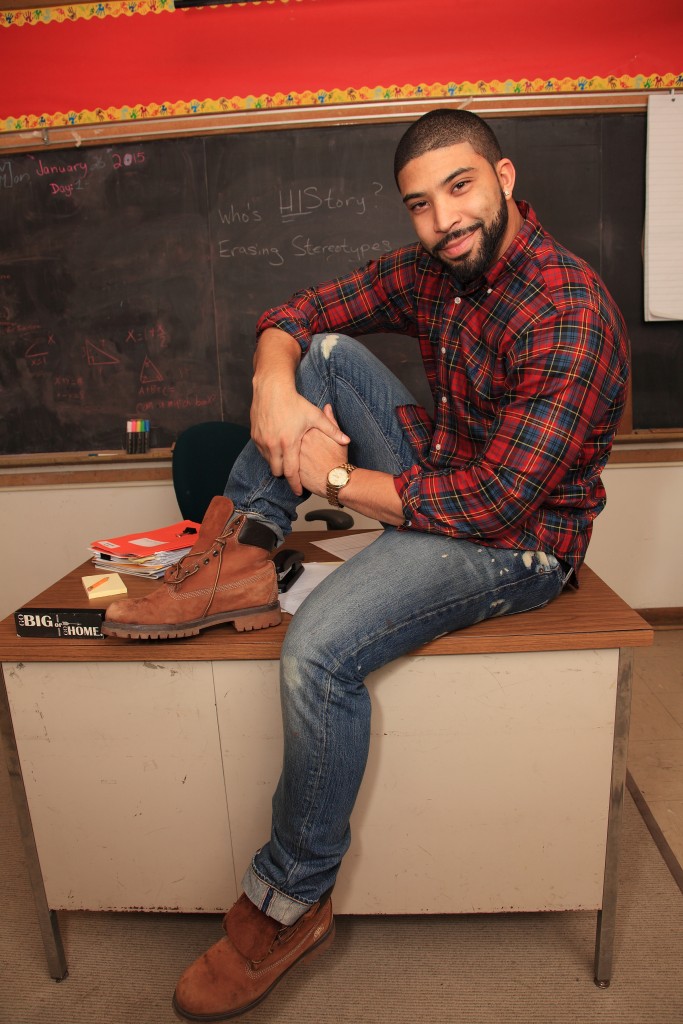So, I’ve gone through the “honeymoon” phase of getting rid of my Teacher’s Desk. After living without it for most of the school year, here is a reflection on teaching without that time-honoured symbol of power (published in Education Canada, March 2016 Issue).
I feel bad when I take a day off. I imagine the supply teacher looking around my classroom, trying to locate that spot where they can clearly define their territory and mark their space as the commander-in-chief of a group of 30 four-foot-tall children. But that use of space to signify a central authority is precisely why I initially chose to get rid of my teacher’s desk. Throughout my first few years of teaching, I found myself retreating to my “station of solace”. This withdrawal to my sanctuary seemed to make my job easier. But for whatever I was gaining in security, I was losing in the one of the most important aspects of teaching: relationships. The desk became a territorial marker in my classroom – a space off-limits to students. The mere presence my desk, and me sitting at it, detracted from the relationships I had worked so hard to build. So, it was time to let it go.
Three months into operating in a space that bears no symbol of authority, I am able to reflect on what it is truly like to teach without the holy grail of representative power – the teacher’s desk.
The first insight that I have realized from teaching without a “pedestal” is that ultimately the true authority of the “teacher” never really changes. My shield (aka desk) may be absent. But because I am invested in my craft as a teacher and devoted to educating children, my position as the “lead learner” is not challenged. Reading this, some may then argue that there really is no point in giving up the teacher’s desk. But I have found that there is much to be gained.
What I chose to lose in a quasi safety net, I gained in classroom synergy. You know those students who never seem to be on task unless you are hovering over them? Try not having a space to mark assignments or answer emails. Without a desk, I can no longer hand out an assignment and have students work independently while I sit at my desk and do my own thing. I must find a space to attend to my teacher duties. So, where do I go? I sit right with the students who are the most constantly distracted. I don’t talk to them. I don’t hover. I simply sit there and do my work while expecting them to do theirs. And guess what? Magically, the distractions dissipate and we all get our work done!
But my “independent work” only takes up a portion of my day. When I had my teacher’s desk, I could sit there and wait for students to come to me with questions about activities or assignments. Now I can’t sit back and wait for students. The lack of a central location for me as a teacher fosters a consistent environment of accountability. I am walking around my classroom non-stop because I have no other choice. Not having my own “home base” creates a space where every student gets help, not just the ones who take the agency to get up and come to the big oak holy grail of the classroom.
Of course there are times when I’ve done all my work and my students are all on task. So without a desk, what do I do then? Ironically enough, I venture out into my classroom and actually talk to my students. This seems counter-intuitive; students are working and there are no distractions but I am the sitting with a group of students and talking to them about their work, which leads to a conversation about what they did on the weekend. When I do this, students are distracted from the task at hand and not “learning.” But a teacher should do more than teach a lesson, give out some practice, and make sure every student gets it. If that were all that teaching entailed, I would not be a teacher. The “non-academic” conversations I have had with students in the last three months have probably eclipsed all of the conversations I have had in the last two years. Without the big desk to distance myself from the students and take a break, I’ve gotten to know my students a whole lot better.
The primary objective of teaching – to inspire and create – is so easily supplanted by a focus on compliance. This is what the crux of teacher preparation prepares teachers for; this is what teachers spend most of their time fussing about. In the real trenches of education, the places where teachers “battle” day in and day out, the emphasis is more on obedience than it is on fostering critical thinking. Losing my desk has helped me get back to the real reason why we are all at school in the first place: to teach, inspire and learn.
[share title=”Share this Post” facebook=”true” twitter=”true” google_plus=”true”]

